

The delay in sending out issue #8 was due to two factors: the Thanksgiving holiday and a business trip I had to take to London. My wife Cindy and I had a wonderful time, taking in many of the regular tourist stops, but also spending some time at both the British Museum (see below) and the British Library. I hope you agree that the wait for this issue was worth it. Please let me know what you think of this issue. Your feedback is always so valuable to me and so appreciated. Oh, and in response to a request, beginning with this issue, I am providing a printer-friendly version of each newsletter. I've made all of them printer-friendly and black & white, accessible from the Newsletter page. Use this version for links, however; all of the printer-friendly version's links are broken.

As a side benefit of my trip to London my wife Cindy and I were able to explore the British Museum, a lifelong dream of mine. In coming issues I will be sharing some of what we saw there.
In this issue, I will cover 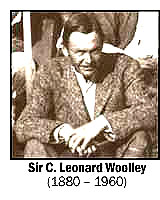 three artifacts from the Babylonian city of Ur, mentioned in the Bible (Gen. 11:29–32) as the home of Terah and his three sons, Haran, Nahor, and Abram, whom God later renamed Abraham.
three artifacts from the Babylonian city of Ur, mentioned in the Bible (Gen. 11:29–32) as the home of Terah and his three sons, Haran, Nahor, and Abram, whom God later renamed Abraham.
Ur is located in Iraq, about halfway between Baghdad and the Persian Gulf, and some 10 miles west of the Euphrates River as it runs today (see the map).
The Englishman Sir Leonard Woolley excavated the site from 1922 to 1934. In the process he discovered a ziggurat, palaces, temples, houses, numerous artifacts, some 2000 skeletons, and thousands of documents inscribed on clay tablets in cuneiform.


^ This is some of the surprisingly modern-looking gold jewelry once worn by the royal women of Ur. Many of the team's discoveries, including the tombs of nearly 2000 people, date from about 2600 BCE.
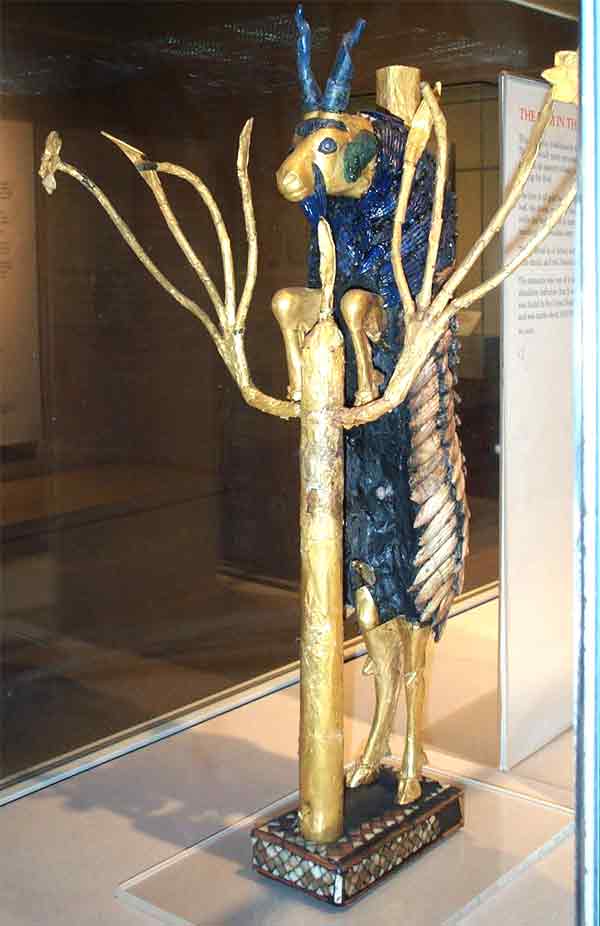
^ This sculpture, which Wooley called "Ram Caught in a Thicket" (though it's actually a goat), was discovered in one of the royal tombs of Ur is made of gold-covered wood and the semi-precious stone lapis lazuli. This sculpture is all the more remarkable in view of the story of Abraham's finding a ram caught in a thicket to offer as a sacrifice in place of his son Isaac (see Genesis 22:13-14).
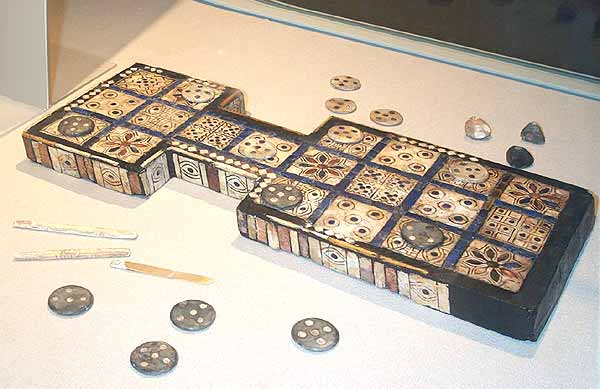
^ A boardgame dated at around 2600 BCE was found in the royal tombs of Ur. The squares are inlaid with either limestone or lapis lazuli. Each player had five pawns, moved according to the results of a toss of a pair of knucklebones (one of a sheep and one of an ox). Apparently landing on a rosette signified good luck, while landing in a non-rosette spaced forced the player to pay a penalty. This much is revealed in a tablet dated at around 177-176 BCE that describes the game.
What do these discoveries reveal to us about Abraham and the book of Genesis? Here are two points.
- The Ur of Genesis 11 really existed, helping to confirm the historical nature of the biblical account. This is all the more significant because of how early in the Genesis record Ur is mentioned (somewhere between 2000 and 1800 BCE). Ur was already a center for politics, literature, and art at least 600 years earlier.
- Because of the Ur excavation we now know that Abraham came from a sophisticated, literate urban center. Although his later life was semi-nomadic, living out of a tent, Abraham and his family were probably among the most educated people of their time. This also supports the account of Abraham's receiving a written document as deed for his burial plot at Machpelah (Gen. 23:16–20).
Want to go deeper?
- Explore almost 90 photos and/or documents relating to Ur in the British Museum
- The University of Chicago's Oriental Institute has an extensive website dedicated to The Royal Tombs of Ur. This website includes a slideshow of numerous other artifacts from Ur.
- A similar website is hosted by the Univerity of Pennsylvania Museum of Archaeology and Anthropology (in Philadelphia, PA) for its exhibit, Treasures from the Royal Tombs of Ur, on exhibit from March 13, 2004 through May 28,2005.
- Saudi Aramco World magazine ran an article on Ur in its March/April 1968 issue (vol. 19, no. 2). You can read the article, "Ur of the Chaldees," online.
- In 1927 E. A. Budge, curator of Egyptian and Assyrian antiquities at the British Museum, in his book The Book of the Cave of Treasures, included two sections entitled "Abraham and the City of Ur" and "Excavations at Ur of the Chaldees." Keep in mind that the excavation continued until 1934, so this information is necessarily incomplete. In fact, an Anglo-American excavation has taken place even more recently. Nevertheless, his account of the Woolley excavation, available online, provides a detailed account of what was discovered in the first five years of the dig.
- Several of Leonard Woolley's books on Ur and ancient Mesopotamia are available. By clicking on the links below, you can purchase them new or used by way of Amazon.com:
Ur of the Chaldees revised and updated edition of Excavations at Ur (used or new)
The Sumerians (used or new)
Buildings of the Third Dynasty (new only)
Discovering the Royal Tombs at Ur (used only)You may also want to read his book on Near Eastern archaeology:
- Digging up the past (used only)
You may also be able to find some of his books in your local public library.

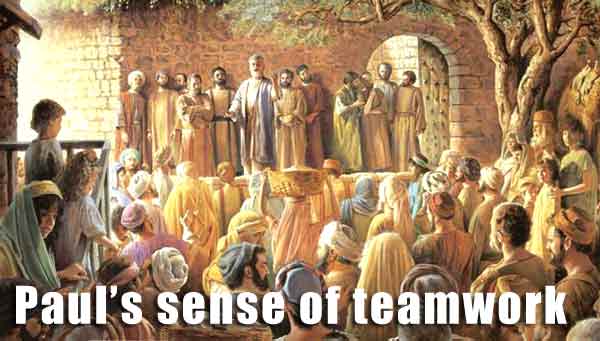
In the pursuit of his Christian ministry, Paul had a keen sense of
teamwork, teamwork with God and with his brothers and sisters. This
awareness he expresses by using compound Greek words that begin with the
prepositional prefix, sun-. With an object in the dative case, sun means "together" or "with."
This same prepositional prefix has carried over into English, occurring in
such words as "symbiotic," "symphony," "synergy" (the Greek sun-,
represented by sym- or syn-). What follows is a brief survey of the words
Paul employed to express this sharing of ministry. You will discover that
such sharing continues among 21st-century Christians. This is definitely connected with the passages we have already examined
(see Issue #7) regarding the believer's connection with Christ. If you are united with
Christ, and I am too, then we are also united with each another. See more
on this subject at the end of this article. That's why Paul calls us "co-citizens" (noun: sumpolitēs – Eph.
2:19), "joint heirs" (noun: sygklēronomos – Rom. 8:17; Eph. 3:6;
compare Heb. 11:9; 1 Peter 3:7), and says we will co-reign (verb:
sumbasileuō – 1 Cor. 4:8; 2 Tim. 2:12). Because we are bound up with
Christ, we share in His city, His inheritance, and His rule. But we also
share the expectation of these future blessings with each other. Because
of this, we co-rejoice (verb: sugkairō – 1 Cor. 12:26; Phil. 2:17,
18). Meanwhile, the struggle continues, and we suffer together (verb:
sumpaschō – 1 Cor. 12:26). To endure such suffering, we co-console
each other (verb: sumparakaleomai – Rom. 1:12). We live and die
together (verbs: suzaō sunapothaneō – 2 Cor. 7:3).
But through it all, we are co-workers (verb: sunergeō; noun:
sunergos). Paul says that he and his associates are "God's
coworkers" (1 Cor. 3:9; 2 Cor. 6:1), an amazing testimony both to the condescension of God—willing to stoop so low to work with the likes of us—and the corresponding elevation of Christians. Paul's letters yield for us an
amazing number of men and women that Paul calls his coworkers: Timothy, 1
Thess. 3:2; Rom. 16:21; "everyone," 1 Cor. 16:16; the Corinthian
Christians, 2 Cor. 1:24; Titus, 2 Cor. 8:23; Priscilla and Aquila, Rom.
16:3; Urbanus, Rom. 16:9; Epaphroditus, Phil. 2:25; Clement and others,
Phil. 4:3; Mark and Aristarchus, Col. 4:10; Phile. 24; Jesus Justus, Col.
4:11; Philemon, Phile. 1; Demas and Luke, Phile. 24. One brother Paul
calls "my yoke-fellow" (noun: suzugos)—Phil. 4:3, a term synonymous
with coworker (though it could be the man's name). Two brothers Paul calls his "co-slaves" (noun:
sundoulos): Epaphras, Col. 1:7; and Tychicus, Col. 4:7. Two he names
as his "co-soldiers" (noun: sustratiōtēs): Epaphroditus, Phil. 2:25;
and Archippus, Phile. 2. Because Paul considers himself a worker, a slave,
a soldier, and an athlete for Christ, those who share the load with him
also share these descriptions. This includes those of us who are laboring
in the kingdom in modern times. As a frequent prisoner for Christ, Paul appreciated those who
ministered to him in prison, even if they themselves were free to come and
go. Four he describes as "co-prisoners" (noun:
sunaichmalōtos): Andronicus and Junias (or the name could be
feminine, Junia), Rom. 16:7; Aristarchus, Col. 4:10; and Epaphras, Phile.
23. It could be that at least some of these voluntarily served Paul so constantly
that their imprisonment was self-imposed. All of these first-century Christians as well as Christians alive today
are partakers or partners in the work of the kingdom (noun:
summetochos – Eph. 3:6; 5:7). We share, have fellowship with, participate with, and
keep company with other believers (verbs: sugkoinōneō,
symmerizomai, synamignumi; noun: sugkoinōnos)—Rom.
11:17; 1 Cor. 5:9, 11; 9:13, 23; Eph. 5:11; Phil. 1:7; 4:14; 2 Thess. 3:14
(compare Rev. 1:9; 18:4). Paul uses several compound terms to describe Christian unity. He says
we must be united, of one accord, literally, "co-souls" (noun:
sumpsuchos—Phil. 2:2. We are conformed together (verb;
summorphoomai, suschōmatizomai; noun: summorphos—
Rom. 8:29; 12:2; Phil. 3:10, 21; compare 1 Peter 1:14), and fitted
together (verb: sunarmologeomai—Eph. 2:21; 4:16. We cooperate and
assist one another (verbs: sunantilambanomai; sunupourgeō—
Rom. 8:26 (compare Luke 10:40); 2 Cor. 1:11. We are built together (verb:
sunoikodomeomai)—Eph. 2:22; and made co-members of the same body
(noun: sussōma)—Eph. 3:6. All of this togetherness, The article in issue #7 explains how Paul expresses the Christian's
union with Christ using the prepositional phrase, together with
Christ (Greek: sun tōi christōi). He reinforces this by
employing compound verbs in which sun- is added to the beginning of
the verb. This occurs in several of the key passages in Paul's writings.
In Gal. 2:20, Paul uses "co-crucified" (sunstauroō) to describe
how becoming united with Christ's death changes the believer. Compare
Matt. 27:44, Mark 15:32, and John 19:32, where the same verb describes the
literal crucifixion of the thieves who died with Jesus. Paul says
that as a result of his union with Christ's death, he has died to the law,
in order to live to God (v. 19). In the next verse he adds that he is no
longer the one living, but Christ is living in him. True, he still lives
"in flesh," but it is a life of trusting in the Son of God, who loved him
and gave himself up in his behalf. Note that this
happens for the individual, not just for believers as a group. Christ died, not for humanity, but for you and me and everyone else as individuals, and only as individuals can we respond to Him. This concept of "co-crucified" recurs in Rom. 6:6. Paul says, "Having
known this, that the old man was co-crucified." Although Christ
goes unmentioned, the connection is definitely between the believer and
Christ—He was the one crucified. The consequence of this death of the old man is a burial, for Paul
earlier says, we were buried together with Him" (sunetaphēmen
autōi) through baptism into death (v. 4). As a result of this union
with Christ's crucifixion and his burial, we also share in the new life of
His resurrection: "we believe that also we will live with him"
(suzēsomen, v. 8). Paul uses these same verbs in the parallel
passage in Colossians (co-buried and co-raised, 2:12; co-made alive, 2:13;
see also 3:1). Because we belong to Christ, we belong to each other. Our union with
Him unites us with every other person who is also united with Him in a
grand and eternal fellowship. Want to go deeper?
For an excellent study on Christian unity, especially as applied to the local church, I highly recommend The Love of Christ in the Local Congregation by my friend and coworker, Larry Deason, which you can order free of charge from the publisher. They even pay the shipping! In case you are interested in doing this kind of research into the way Greek words are used in the New Testament, I would recommend Englishman's Greek Concordance. If you click on the link in red, you can go to its listing at Amazon.com and see how it is laid out, according to Greek alphabetical order of the underlying Greek words. There's an index in the back so that you can look up the English word in a text and find out all of the Greek words it represents. It is also keyed to the Greek dictionary in Strong's Concordance. In this way, you can study all of the occurrences of a Greek word, not just those that happen to be translated in the same way. You can get Englishman's Greek Concordance new for not much over $20, which is really a bargain. Used copies are also available, cutting the price nearly in half. You can also watch out for Englishman's Greek Concordance at used bookstores; it is sometimes available at such places. The Possibility of Apostasy and the Security of the Believer—Qualify for this free e-document! You won't want to miss this handy summary of New Testament teaching on whether a Christian can fall from grace, and also whether he or she can be sure of salvation. This is a summary of 53 passages, plus pointers for what to study and who to read if you want to Go Deeper. Just send us the e-mail addresses of five friends who could benefit from receiving a free subscription to DeeperStudy Newsletter. Claim your Security/ Apostasy study today! Free offers from earlier issues (for 5 new subscribers): we must remember, is not a natural state—far
from it! If left to ourselves, we human beings split apart at every seam,
whether it is race, ethnicity, gender, or class. It is only Christ that
binds us together. Only in Him can it be possible to say that in Christ
there is neither Jew nor Greek, slave nor free, neither barbarian or
Scythian, male or female; all are one in Christ Jesus (Gal. 3:28; 1 Cor.
12:13; Col. 3:11).
we must remember, is not a natural state—far
from it! If left to ourselves, we human beings split apart at every seam,
whether it is race, ethnicity, gender, or class. It is only Christ that
binds us together. Only in Him can it be possible to say that in Christ
there is neither Jew nor Greek, slave nor free, neither barbarian or
Scythian, male or female; all are one in Christ Jesus (Gal. 3:28; 1 Cor.
12:13; Col. 3:11).
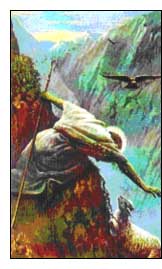
when you want to "Dive Deeper" in your study of the Holy Scriptures.

DeeperStudy Homepage
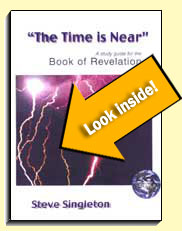 Special Holiday Offer!
Special Holiday Offer!As you may have seen on DeeperStudy.com, the third edition of Overcoming, my study guide for Revelation, is selling for $39.95. But we still have a few copies of the second edition, called The Time is Near! It is 279 pages and is the same as the 3rd edition, including the 65-page introduction, over 100 charts, the special 50-page section on the hermeneutics of the "Left Behind" series, and a scripture index to spiritual songs based on Revelation, but without the additional material on chapters 2 and 3. You must snap up this bargain at only $24.95 plus shipping! This offer is good only while our supplies last, so hurry!
DeeperStudy privacy policy: Any information DeeperStudy gathers about you will be used solely to serve you better. It will not be shared with, rented to, or sold to anyone for any purpose whatsoever. Never! Period!
Copyright ©2004 Steve Singleton. All rights reserved.